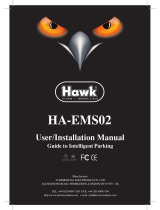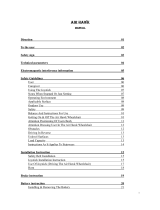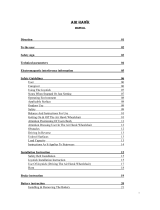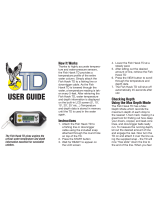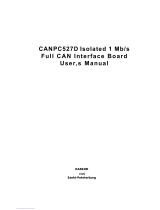Page is loading ...

MVME5100
Single Board Computer
Programmer’s
Reference Guide
V5100A/PG1
November 2000 Edition

© Copyright 2000 Motorola, Inc.
All rights reserved.
Printed in the United States of America.
Motorola and the Motorola logo are registered trademarks and AltiVec is a trademark of
Motorola, Inc.
PowerPC and the PowerPC logo are registered trademarks; and PowerPC 750 is a
trademark of International Business Machines Corporation and are used by Motorola, Inc.
under license from International Business Machines Corporation.
All other products mentioned in this document are trademarks or registered trademarks of
their respective holders.

Safety Summary
The following general safety precautions must be observed during all phases of operation, service, and repair of this
equipment. Failure to comply with these precautions or with specific warnings elsewhere in this manual could result
in personal injury or damage to the equipment.
The safety precautions listed below represent warnings of certain dangers of which Motorola is aware. You, as the
user of the product, should follow these warnings and all other safety precautions necessary for the safe operation of
the equipment in your operating environment.
Ground the Instrument.
To minimize shock hazard, the equipment chassis and enclosure must be connected to an electrical ground. If the
equipment is supplied with a three-conductor AC power cable, the power cable must be plugged into an approved
three-contact electrical outlet, with the grounding wire (green/yellow) reliably connected to an electrical ground
(safety ground) at the power outlet. The power jack and mating plug of the power cable meet International
Electrotechnical Commission (IEC) safety standards and local electrical regulatory codes.
Do Not Operate in an Explosive Atmosphere.
Do not operate the equipment in any explosive atmosphere such as in the presence of flammable gases or fumes.
Operation of any electrical equipment in such an environment could result in an explosion and cause injury or damage.
Keep Away From Live Circuits Inside the Equipment.
Operating personnel must not remove equipment covers. Only Factory Authorized Service Personnel or other
qualified service personnel may remove equipment covers for internal subassembly or component replacement or any
internal adjustment. Service personnel should not replace components with power cable connected. Under certain
conditions, dangerous voltages may exist even with the power cable removed. To avoid injuries, such personnel
should always disconnect power and discharge circuits before touching components.
Use Caution When Exposing or Handling a CRT.
Breakage of a Cathode-Ray Tube (CRT) causes a high-velocity scattering of glass fragments (implosion). To prevent
CRT implosion, do not handle the CRT and avoid rough handling or jarring of the equipment. Handling of a CRT
should be done only by qualified service personnel using approved safety mask and gloves.
Do Not Substitute Parts or Modify Equipment.
Do not install substitute parts or perform any unauthorized modification of the equipment. Contact your local
Motorola representative for service and repair to ensure that all safety features are maintained.
Observe Warnings in Manual.
Warnings, such as the example below, precede potentially dangerous procedures throughout this manual. Instructions
contained in the warnings must be followed. You should also employ all other safety precautions which you deem
necessary for the operation of the equipment in your operating environment.
Warning
To prevent serious injury or death from dangerous voltages, use extreme
caution when handling, testing, and adjusting this equipment and its
components.

Flammability
All Motorola PWBs (printed wiring boards) are manufactured with a flammability rating
of 94V-0 by UL-recognized manufacturers.
EMI Caution
!
Caution
This equipment generates, uses and can radiate electromagnetic energy. It
may cause or be susceptible to electromagnetic interference (EMI) if not
installed and used with adequate EMI protection.
Lithium Battery Caution
This product contains a lithium battery to power the clock and calendar circuitry.
!
Caution
Danger of explosion if battery is replaced incorrectly. Replace battery only
with the same or equivalent type recommended by the equipment
manufacturer. Dispose of used batteries according to the manufacturer’s
instructions.
Attention
!
Il y a danger d’explosion s’il y a remplacement incorrect de la batterie.
Remplacer uniquement avec une batterie du même type ou d’un type
équivalent recommandé par le constructeur. Mettre au rebut les batteries
usagées conformément aux instructions du fabricant.
Vorsicht
!
Explosionsgefahr bei unsachgemäßem Austausch der Batterie. Ersatz nur
durch denselben oder einen vom Hersteller empfohlenen Typ. Entsorgung
gebrauchter Batterien nach Angaben des Herstellers.

CE Notice (European Community)
Motorola Computer Group products with the CE marking comply with the EMC Directive
(89/336/EEC). Compliance with this directive implies conformity to the following
European Norms:
EN55022 “Limits and Methods of Measurement of Radio Interference Characteristics
of Information Technology Equipment”; this product tested to Equipment Class B
EN50082-1:1997 “Electromagnetic Compatibility—Generic Immunity Standard,
Part 1. Residential, Commercial and Light Industry”
System products also fulfill EN60950 (product safety) which is essentially the requirement
for the Low Voltage Directive (73/23/EEC).
Board products are tested in a representative system to show compliance with the above
mentioned requirements. A proper installation in a CE-marked system will maintain the
required EMC/safety performance.
In accordance with European Community directives, a “Declaration of Conformity” has
been made and is on file within the European Union. The “Declaration of Conformity” is
available on request. Please contact your sales representative.
Notice
While reasonable efforts have been made to assure the accuracy of this document,
Motorola, Inc. assumes no liability resulting from any omissions in this document, or from
the use of the information obtained therein. Motorola reserves the right to revise this
document and to make changes from time to time in the content hereof without obligation
of Motorola to notify any person of such revision or changes.
Electronic versions of this material may be read online, downloaded for personal use, or
referenced in another document as a URL to the Motorola Computer Group website. The
text itself may not be published commercially in print or electronic form, edited, translated,
or otherwise altered without the permission of Motorola, Inc.
It is possible that this publication may contain reference to or information about Motorola
products (machines and programs), programming, or services that are not available in your
country. Such references or information must not be construed to mean that Motorola
intends to announce such Motorola products, programming, or services in your country.

Limited and Restricted Rights Legend
If the documentation contained herein is supplied, directly or indirectly, to the U.S.
Government, the following notice shall apply unless otherwise agreed to in writing by
Motorola, Inc.
Use, duplication, or disclosure by the Government is subject to restrictions as set forth in
subparagraph (b)(3) of the Rights in Technical Data clause at DFARS 252.227-7013
(Nov. 1995) and of the Rights in Noncommercial Computer Software and Documentation
clause at DFARS 252.227-7014 (Jun. 1995).
Motorola, Inc.
Computer Group
2900 South Diablo Way
Tempe, Arizona 85282

Preface
The MVME5100 Single Board Computer Programmer’s Reference Guide provides the
information you will need to program your MVME5100 Single Board Computer.
The MVME5100 is a high-performance VME single board computer featuring the
Motorola Computer Group (MCG) PowerPlus II architecture with a choice of PowerPC
®
processors—either Motorola’s MPC7400 with AltiVec
™
technology for algorithmic
intensive computations or the low-power MPC750.
As of the printing date of this manual, the MVME5100 is available in the configurations
shown below. All models of the MVME5100 are available with either VME SCANBE
front panel (-01x1) or IEEE 1101 compatible front panel (-01x3).
Model Processor
Memory
Handles
MVME5100-0131 MCP750
@450 MHz
64MB SDRAM SCANBE
MVME5100-0161
512MB SDRAM
MVME5100-0133
64MB SDRAM IEEE 1101
MVME5100-0163
512MB SDRAM
MVME5101-0131 MCP7400
@400 MHz
64MB SDRAM SCANBE
MVME5101-0161
512MB SDRAM
MVME5101-0133
64MB SDRAM IEEE 1101
MVME5101-0163
512MB SDRAM

Comments and Suggestions
M
otorola welcomes and appreciates your comments on its documentation. We want to know
what you think about our manuals and how we can improve them. Mail comments to:
Motorola Computer Group
Reader Comments DW164
2900 S. Diablo Way
Tempe, Arizona 85282
You can also submit comments to the following e-mail address:
reader-comments@mcg.mot.com
In all your correspondence, please provide the name of your company, followed by your
name and position. Please be sure to include the title and part number of the manual along
with a brief explanation on how you used it. Thereafter, summarize your feelings about its
strengths and weaknesses and provide us with any recommendations for improvements.
Conventions Used in This Manual
The following typographical conventions are used in this document:
bold
is used for user input that you type just as it appears; it is also used for commands,
options and arguments to commands, and names of programs, directories and files.
italic
is used for names of variables to which you assign values. Italic is also used for
comments in screen displays and examples, and to introduce new terms.
courier
is used for system output (for example, screen displays, reports), examples, and system
prompts.
<Enter>, <Return> or <CR>
represents the carriage return or Enter key.
Ctrl
represents the Control key. Execute control characters by pressing the Ctrl key and the
letter simultaneously, for example, Ctrl-d.

Terminology
A character precedes a data or address parameter to specify the numeric format, as follows
(if not specified, the format is hexadecimal):
An asterisk (#) following a signal name for signals that are level significant denotes that the
signal is true or valid when the signal is low.
An asterisk (#) following a signal name for signals that are edge significant denotes that
the#actions initiated by that signal occur on high to low transition.
In this manual, assertion and negation are used to specify forcing a signal to a particular
state. In particular, assertion and assert refer to a signal that is active or true; negation and
negate indicate a signal that is inactive or false. These terms are used independently of the
voltage level (high or low) that they represent.
Data and address sizes are defined as follows:
0x Specifies a hexadecimal number
% Specifies a binary number
& Specifies a decimal number
Byte 8 bits, numbered 0 through 7, with bit 0 being the least significant.
Half word 16 bits, numbered 0 through 15, with bit 0 being the least significant.
Word 32 bits, numbered 0 through 31, with bit 0 being the least significant.
Double word 64 bits, numbered 0 through 63, with bit 0 being the least significant.

xi
Contents
CHAPTER 1 Product Data and Memory Maps
Introduction................................................................................................................1-1
What this Guide Provides...................................................................................1-1
Memory maps ............................................................................................................1-4
Processor Memory Map......................................................................................1-4
PCI / VME Memory Map...................................................................................1-4
System Bus.................................................................................................................1-4
Processors ...........................................................................................................1-4
Processor Type Identification .............................................................................1-4
Processor PLL Configuration .............................................................................1-5
L2 Cache.............................................................................................................1-5
L2 Cache SRAM Size.........................................................................................1-5
Cache Speed........................................................................................................1-5
Flash Memory.....................................................................................................1-5
System Memory..................................................................................................1-6
Serial Presence Detect (SPD) Definitions ..........................................................1-6
Hawk ASIC................................................................................................................1-6
Hawk I2C interface and configuration information............................................1-6
Vital Product Data and Serial Presence Detect Data ..........................................1-7
PCI Local Bus.....................................................................................................1-7
The Ethernet Controller......................................................................................1-8
PMC/PCI Expansion Slots..................................................................................1-8
The Universe ASIC.............................................................................................1-8
PCI Configuration Space....................................................................................1-8
PCI Arbitration Assignments for Hawk ASIC .................................................1-10
Hawk External Register Bus Address Assignments.........................................1-11
MVME5100 Hawk External Register Bus Summary................................1-11
Status Register ..................................................................................................1-13
MODFAIL Bit Register ....................................................................................1-14
MODRST Bit Register......................................................................................1-15
TBEN Bit Register............................................................................................1-16
NVRAM/RTC & Watchdog Timer...................................................................1-16
Software Readable Header Register.................................................................1-16
Geographical Address Register (VME board)..................................................1-17
Extended Features Register 1 ...........................................................................1-17
Extended Features Register 2 ...........................................................................1-18
INTERRUPT HANDLING......................................................................................1-19
Hawk MPIC......................................................................................................1-19

xii
CHAPTER 2 Hawk PCI Host Bridge & Multi-Processor Interrupt Controller
Introduction ...............................................................................................................2-1
Overview............................................................................................................2-1
Features ..............................................................................................................2-1
Block Diagram...........................................................................................................2-3
Functional Description ..............................................................................................2-4
Architectural Overview......................................................................................2-4
PPC Bus Interface ..............................................................................................2-5
PPC Address Mapping................................................................................2-6
PPC Slave....................................................................................................2-7
PPC FIFO....................................................................................................2-9
PPC Master................................................................................................2-10
PPC Arbiter...............................................................................................2-15
PPC Parity.................................................................................................2-17
PPC Bus Timer..........................................................................................2-18
PCI Bus Interface .............................................................................................2-19
PCI Address Mapping...............................................................................2-19
PCI Slave...................................................................................................2-22
PCI FIFO...................................................................................................2-26
PCI Master ................................................................................................2-26
Generating PCI Cycles..............................................................................2-29
PCI Arbiter................................................................................................2-34
Endian Conversion ...........................................................................................2-38
When PPC Devices are Big-Endian..........................................................2-38
When PPC Devices are Little Endian .......................................................2-39
PHB Registers...........................................................................................2-40
Error Handling..................................................................................................2-41
Watchdog Timers..............................................................................................2-42
PCI/PPC Contention Handling.........................................................................2-44
Transaction Ordering........................................................................................2-47
PHB Hardware Configuration..........................................................................2-49
Multi-Processor Interrupt Controller (MPIC)..........................................................2-50
MPIC Features:.................................................................................................2-50
Architecture......................................................................................................2-51
External Interrupt Interface ..............................................................................2-51
CSR’s Readability ............................................................................................2-52
Interrupt Source Priority...................................................................................2-52
Processor’s Current Task Priority.....................................................................2-53
Nesting of Interrupt Events ..............................................................................2-53
Spurious Vector Generation..............................................................................2-53
Interprocessor Interrupts (IPI)..........................................................................2-54

xiii
8259 Compatibility...........................................................................................2-54
Hawk Internal Errror Interrupt..........................................................................2-54
Timers...............................................................................................................2-55
Interrupt Delivery Modes..................................................................................2-55
Block Diagram Description..............................................................................2-56
Program Visible Registers.........................................................................2-58
Interrupt Pending Register (IPR)...............................................................2-58
Interrupt Selector (IS)................................................................................2-58
Interrupt Request Register (IRR)...............................................................2-59
In-Service Register (ISR) ..........................................................................2-59
Interrupt Router .........................................................................................2-59
Programming Notes..........................................................................................2-61
External Interrupt Service..........................................................................2-61
Reset State .................................................................................................2-62
Operation ..........................................................................................................2-63
Interprocessor Interrupts............................................................................2-63
Dynamically Changing I/O Interrupt Configuration.................................2-63
EOI Register..............................................................................................2-64
Interrupt Acknowledge Register................................................................2-64
8259 Mode.................................................................................................2-64
Current Task Priority Level.......................................................................2-64
Architectural Notes...........................................................................................2-65
Effects of Interrupt Serialization.......................................................................2-65
Registers...................................................................................................................2-66
PPC Registers ...................................................................................................2-67
Vendor ID/Device ID Registers ................................................................2-69
Revision ID Register .................................................................................2-69
General Control-Status/Feature Registers.................................................2-70
PPC Arbiter/PCI Arbiter Control Registers...............................................2-72
Hardware Control-Status/Prescaler Adjust Register .................................2-76
PPC Error Test/Error Enable Register.......................................................2-78
PPC Error Status Register..........................................................................2-81
PPC Error Address Register......................................................................2-83
PPC Error Attribute Register.....................................................................2-84
PCI Interrupt Acknowledge Register ........................................................2-86
PPC Slave Address (0,1 and 2) Registers..................................................2-87
PPC Slave Offset/Attribute (0, 1 and 2) Registers ....................................2-88
PPC Slave Address (3) Register................................................................2-89
PPC Slave Offset/Attribute (3) Registers..................................................2-90
WDTxCNTL Registers..............................................................................2-91
WDTxSTAT Registers..............................................................................2-94
General Purpose Registers.........................................................................2-94

xiv
PCI Registers....................................................................................................2-95
Vendor ID/ Device ID Registers...............................................................2-96
PCI Command/ Status Registers...............................................................2-97
Revision ID/ Class Code Registers ...........................................................2-99
Header Type Register................................................................................2-99
MPIC I/O Base Address Register ...........................................................2-100
MPIC Memory Base Address Register...................................................2-100
PCI Slave Address (0,1,2, and 3) Registers ............................................2-101
PCI Slave Attribute/ Offset (0,1,2 and 3) Registers................................2-102
CONFIG_ADDRESS Register ...............................................................2-104
CONFIG_DATA Register ......................................................................2-107
MPIC Registers ..............................................................................................2-108
MPIC Registers.......................................................................................2-108
Feature Reporting Register .....................................................................2-111
Global Configuration Register................................................................2-112
Vendor Identification Register................................................................2-114
Processor Init Register ............................................................................2-114
IPI Vector/Priority Registers...................................................................2-115
Spurious Vector Register ........................................................................2-116
Timer Frequency Register.......................................................................2-116
Timer Current Count Registers...............................................................2-117
Timer Basecount Registers .....................................................................2-118
Timer Vector/Priority Registers..............................................................2-119
Timer Destination Registers....................................................................2-120
External Source Vector/Priority Registers..............................................2-120
External Source Destination Registers....................................................2-122
Hawk Internal Error Interrupt Vector/Priority Register..........................2-123
Hawk Internal Error Interrupt Destination Register................................2-124
Interprocessor Interrupt Dispatch Registers............................................2-124
Current Task Priority Registers...............................................................2-125
Interrupt Acknowledge Registers............................................................2-125
End-of-Interrupt Registers ......................................................................2-126

xv
CHAPTER 3 System Memory Controller (SMC)
Introduction................................................................................................................3-1
Overview.............................................................................................................3-1
Bit Ordering Convention ....................................................................................3-1
Features...............................................................................................................3-1
Block Diagrams .........................................................................................................3-2
Functional Description...............................................................................................3-6
SDRAM Accesses...............................................................................................3-6
Four-beat Reads/Writes...............................................................................3-6
Single-beat Reads/Writes ............................................................................3-6
Address Pipelining.......................................................................................3-6
Page Holding ...............................................................................................3-7
SDRAM Speeds...........................................................................................3-7
SDRAM Organization ........................................................................................3-9
PPC60x Bus Interface.........................................................................................3-9
Responding to Address Transfers................................................................3-9
Completing Data Transfers..........................................................................3-9
PPC60x Data Parity...................................................................................3-10
PPC60x Address Parity .............................................................................3-10
Cache Coherency.......................................................................................3-11
Cache Coherency Restrictions...................................................................3-11
L2 Cache Support......................................................................................3-11
SDRAM ECC ...................................................................................................3-11
Cycle Types...............................................................................................3-11
Error Reporting..........................................................................................3-12
Error Logging............................................................................................3-13
ROM/Flash Interface ........................................................................................3-14
ROM/Flash Speeds....................................................................................3-19
I2C Interface .....................................................................................................3-22
I2C Byte Write...........................................................................................3-23
I2C Random Read .....................................................................................3-25
I2C Current Address Read.........................................................................3-27
I2C Page Write ..........................................................................................3-29
I2C Sequential Read..................................................................................3-31
Refresh/Scrub....................................................................................................3-34
CSR Accesses...................................................................................................3-34
External Register Set ........................................................................................3-34
Chip Configuration ...........................................................................................3-35
Programming Model................................................................................................3-35
CSR Architecture..............................................................................................3-35
Register Summary.............................................................................................3-36

xvi
Detailed Register Bit Descriptions...................................................................3-38
Vendor/Device Register............................................................................3-39
Revision ID/General Control Register......................................................3-39
SDRAM Enable and Size Register (Blocks A, B, C, D)...........................3-41
SDRAM Base Address Register (Blocks A/B/C/D).................................3-43
CLK Frequency Register...........................................................................3-44
ECC Control Register ...............................................................................3-45
Error Logger Register ...............................................................................3-49
Error_Address Register.............................................................................3-51
Scrub/Refresh Register..............................................................................3-51
Scrub Address Register.............................................................................3-52
ROM A Base/Size Register.......................................................................3-53
ROM B Base/Size Register.......................................................................3-56
ROM Speed Attributes Registers..............................................................3-58
Data Parity Error Log Register .................................................................3-60
Data Parity Error Address Register...........................................................3-61
Data Parity Error Upper Data Register .....................................................3-61
Data Parity Error Lower Data Register.....................................................3-62
I2C Clock Prescaler Register....................................................................3-63
I2C Control Register .................................................................................3-63
I2C Status Register....................................................................................3-64
I2C Transmitter Data Register..................................................................3-65
I2C Receiver Data Register.......................................................................3-66
SDRAM Enable and Size Register (Blocks E,F,G,H)..............................3-66
SDRAM Base Address Register (Blocks E/F/G/H)..................................3-67
SDRAM Speed Attributes Register ..........................................................3-68
Address Parity Error Log Register............................................................3-70
Address Parity Error Address Register .....................................................3-71
32-Bit Counter...........................................................................................3-72
External Register Set.................................................................................3-72
tben Register..............................................................................................3-73
Software Considerations..........................................................................................3-74
Programming ROM/Flash Devices ..................................................................3-74
Writing to the Control Registers.......................................................................3-75
Initializing SDRAM Related Control Registers...............................................3-75
SDRAM Speed Attributes.........................................................................3-75
SDRAM Size.............................................................................................3-76
I2C EEPROMs..........................................................................................3-76
SDRAM Base Address and Enable...........................................................3-76
SDRAM Control Registers Initialization Example...................................3-77
Optional Method for Sizing SDRAM .......................................................3-83
ECC Codes ..............................................................................................................3-86

xvii
CHAPTER 4 Hawk Programming Details
Introduction................................................................................................................4-1
PCI Arbitration...........................................................................................................4-1
Hawk MPIC External Interrupts.........................................................................4-1
8259 Interrupts....................................................................................................4-2
Exceptions..................................................................................................................4-4
Sources of Reset..................................................................................................4-4
Soft Reset............................................................................................................4-4
CPU Reset...........................................................................................................4-4
Error Notification and Handling.........................................................................4-5
Endian Issues .............................................................................................................4-6
Processor/Memory Domain................................................................................4-8
MPIC’s Involvement...........................................................................................4-8
PCI Domain ........................................................................................................4-8
APPENDIX A Related Documentation
Motorola Computer Group Documents....................................................................A-1
Manufacturers’ Documents.......................................................................................A-2
Related Specifications...............................................................................................A-3

xix
List of Figures
Figure 1-1. MVME5100 Block Diagram...................................................................1-3
Figure 2-1. Hawk PCI Host Bridge Block Diagram..................................................2-3
Figure 2-2. PPC to PCI Address Decoding................................................................2-6
Figure 2-3. PPC to PCI Address Translation.............................................................2-7
Figure 2-4. PCI to PPC Address Decoding..............................................................2-20
Figure 2-5. PCI to PPC Address Translation...........................................................2-21
Figure 2-6. PCI Spread I/O Address Translation.....................................................2-31
Figure 2-7. Big-to-Little-Endian Data Swap ...........................................................2-39
Figure 2-8. Serial Mode Interrupt Scan ...................................................................2-51
Figure 2-9. MPIC Block Diagram ...........................................................................2-57
Figure 3-1. Hawk Used with Synchronous DRAM in a System ..............................3-2
Figure 3-2. Hawk’s System Memory Controller Internal Data Paths........................3-3
Figure 3-3. Overall SDRAM Connections.................................................................3-4
Figure 3-4. Hawk’s System Memory Controller Block Diagram..............................3-5
Figure 3-5. Programming Sequence for I
2
C Byte Write..........................................3-24
Figure 3-6. Programming Sequence for I
2
C Random Read ....................................3-26
Figure 3-7. Programming Sequence for I
2
C Current Address Read........................3-28
Figure 3-8. Programming Sequence for I
2
C Page Write..........................................3-30
Figure 3-9. Programming Sequence for I
2
C Sequential Read.................................3-33
Figure 3-10. Read/Write Check-bit Data Paths........................................................3-46
Figure 4-1. Big-Endian Mode....................................................................................4-6
Figure 4-2. Little-Endian Mode.................................................................................4-7

xxi
List of Tables
Table 1-1. MVME Key Features................................................................................1-2
Table 1-2. IDSEL Mapping for PCI Devices.............................................................1-9
Table 1-3. On-Board PCI Device Identification ........................................................1-9
Table 1-4. PCI Arbitration Assignments for Hawk ASIC .......................................1-10
Table 1-5. Hawk External Register Bus Summary ..................................................1-11
Table 1-6. MVME5100 Status Register...................................................................1-13
Table 1-7. MODFAIL Bit Register ..........................................................................1-14
Table 1-8. MODRST Bit Register............................................................................1-15
Table 1-9. TBEN Bit Register..................................................................................1-16
Table 1-10. Extended Features Register 1................................................................1-17
Table 1-11. Extended Features Register 2................................................................1-18
Table 1-12. Hawk MPIC Interrupt Assignments......................................................1-19
Table 2-1. PPC Slave Response Command Types.....................................................2-8
Table 2-2. PPC Master Transaction Profiles and Starting Offsets...........................2-11
Table 2-3. PPC Master Write Posting Options.........................................................2-12
Table 2-4. PPC Master Read Ahead Options...........................................................2-12
Table 2-5. PPC Master Transfer Types ....................................................................2-14
Table 2-6. PPC Arbiter Pin Assignments.................................................................2-15
Table 2-7. PCI Slave Response Command Types....................................................2-23
Table 2-8. PCI Master Command Codes .................................................................2-27
Table 2-9. PCI Arbiter Pin Description....................................................................2-34
Table 2-10. Fixed Mode Priority Level Setting .......................................................2-35
Table 2-11. Mixed Mode Priority Level Setting ......................................................2-36
Table 2-12. Arbitration Setting ................................................................................2-37
Table 2-13. Address Modification for Little-Endian Transfers ...............................2-40
Table 2-14. WDTxCNTL Programming..................................................................2-44
Table 2-15. PHB Hardware Configuration ..............................................................2-49
Table 2-16. PPC Register Map for PHB..................................................................2-67
Table 2-17. PCI Configuration Register ..................................................................2-95
Table 2-18. PCI I/O Register....................................................................................2-96
Table 2-19. MPIC Register Map............................................................................2-108
Table 2-20. Cascade Mode Encoding ....................................................................2-113
Table 2-21. Tie Mode Encoding.............................................................................2-113

xxii
Table 3-1. 60x Bus to SDRAM Estimated Access Timing at 100 MHz
with PC100 SDRAMs (CAS_latency of 2)...............................................................3-7
Table 3-2. Error Reporting.......................................................................................3-12
Table 3-3. PPC60x to ROM/Flash (16 Bit Width)
Address Mapping.....................................................................................................3-16
Table 3-4. PPC60x to ROM/Flash (64 Bit Width)
Address Mapping (Continued) ................................................................................3-17
Table 3-5. PPC60x Bus to ROM/Flash Access Timing
(120ns @ 100 MHz)................................................................................................3-19
Table 3-6. PPC60x Bus to ROM/Flash Access Timing
(80ns @ 100 MHz)..................................................................................................3-20
Table 3-7. PPC60x Bus to ROM/Flash Access Timing
(50ns @ 100 MHz)..................................................................................................3-20
Table 3-8. PPC60x Bus to ROM/Flash Access Timing
(30ns @ 100 MHz)..................................................................................................3-21
Table 3-9. Register Summary..................................................................................3-36
Table 3-10. Block_A/B/C/D/E/F/G/H Configurations............................................3-42
Table 3-11. ROM Block A Size Encoding ..............................................................3-54
Table 3-12. rom_a_rv and rom_b_rv encoding .......................................................3-54
Table 3-13. Read/Write to ROM/Flash....................................................................3-55
Table 3-14. ROM Block B Size Encoding ..............................................................3-57
Table 3-15. ROM Speed Bit Encodings ..................................................................3-59
Table 3-16. Trc Encoding ........................................................................................3-69
Table 3-17. tras Encoding........................................................................................3-69
Table 3-18. Deriving tras, trp, trcd and trc Control Bit Values
from SPD Information.............................................................................................3-78
Table 3-19. Programming SDRAM SIZ Bits ..........................................................3-81
Table 3-20. Address Lists for Different Block Size Checks....................................3-85
Table 3-21. Syndrome Codes Ordered by Bit in Error............................................3-86
Table 3-22. Single Bit Errors Ordered by Syndrome Code.....................................3-87
Table 4-1. MPIC Interrupt Assignments....................................................................4-1
Table 4-2. PBC ISA Interrupt Assignments ..............................................................4-3
Table 4-3. Error Notification and Handling...............................................................4-5
Table A-1. Motorola Computer Group Documents .................................................A-1
Table A-2. Manufacturers’ Documents ...................................................................A-2
Table A-3. Related Specifications ...........................................................................A-3

1-1
1
1Product Data
and Memory Maps
Introduction
The MVME5100 is a state-of-the-art Single Board Computer. It
incorporates Motorola’s PowerPlus II architecture with a choice of
PowerPC processors—either Motorola’s MPC7400 with AltiVec™
technology for algorithmic intensive computations or the low-power
MPC750.
The MVME5100 incorporates a highly optimized PCI interface and
memory controller enabling up to 582MB memory read bandwidth and
640 MB burst write bandwidth.
The on-board Hawk ASIC provides the bridge function between the
processor’s bus and the PCI bus. It provides 32-bit addressing and 64-bit
data; however, 64-bit addressing (dual address cycle) is not supported. The
ASIC also supports various processor external bus frequencies up to
10MHz.
Note U
nless otherwise specified, the designation “MVME5100” refers to all
models of the MVME5100-series Single Board Computers.
What this Guide Provides
This guide provides programming information and other data applicable to
the MVME5100. As an added convienience, it also provides details of the
chip set (Hawk) programming functions. It is important to note that much
of the board’s programming functionality is associated with the Hawk
ASIC. Additional programming information can also be found in the
following manuals (refer to Appendix A, Related Documentation):
❏ PPCBug Firmware User’s Manual
❏ PPCBug Diagnostics Manual
❏ MPC750 RISC Microprocessor User’s Manual
❏ MPC7400 RISC Microprocessor User’s Manual
❏ Universe II User Manual
/
